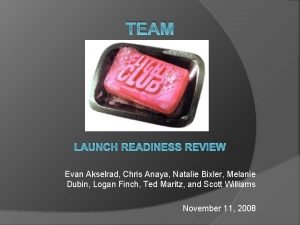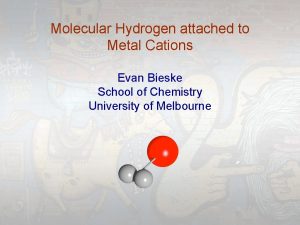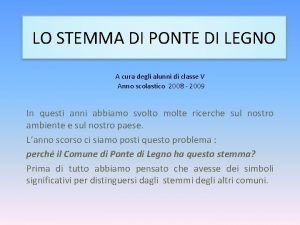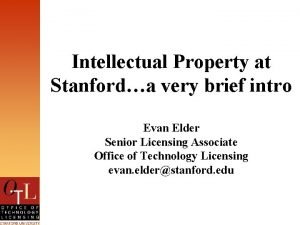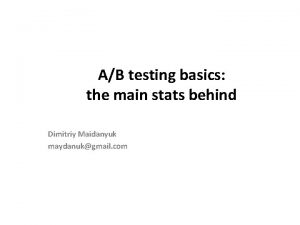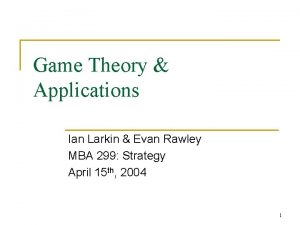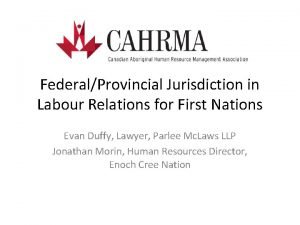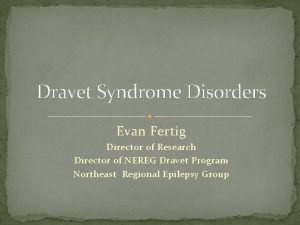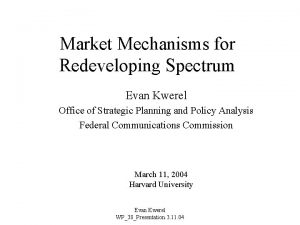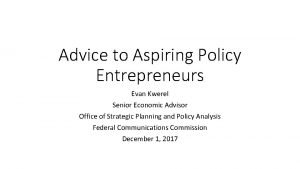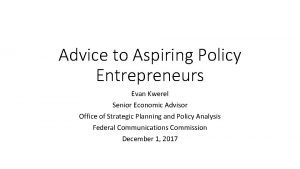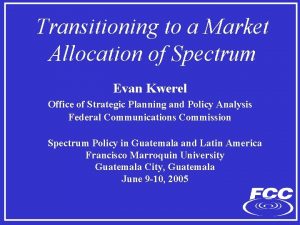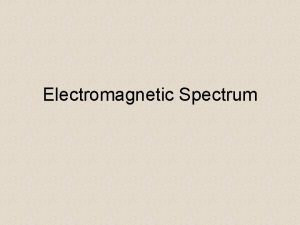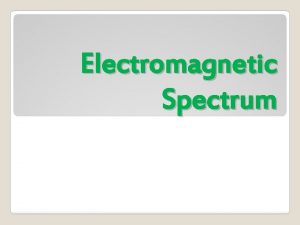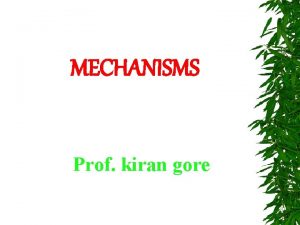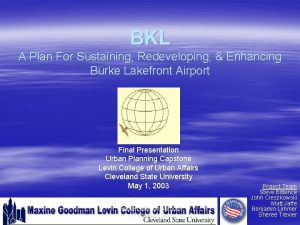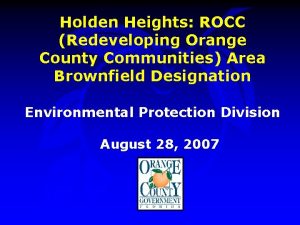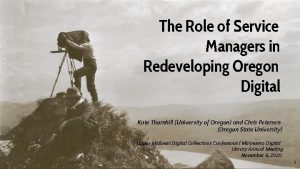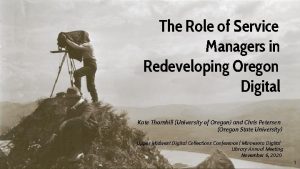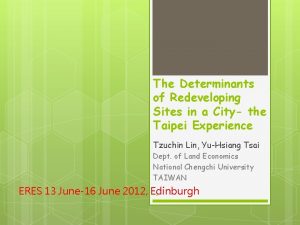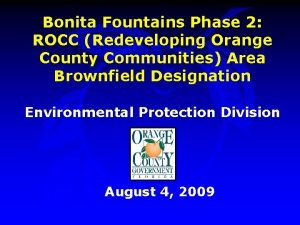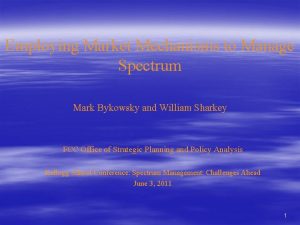Market Mechanisms for Redeveloping Spectrum Evan Kwerel Office




















- Slides: 20

Market Mechanisms for Redeveloping Spectrum Evan Kwerel Office of Strategic Planning and Policy Analysis Federal Communications Commission DIMACS Workshop October 7, 2004

Disclaimer • The opinions expressed in this talk are those of the author and do not necessarily represent the views of the FCC or any other members of its staff. • Talk is based on joint work with John Williams. Evan Kwerel 2

Only about 7% (185 MHz) of Spectrum in 300 -3000 MHz Range Is Fully Available to Market Today PCS 3% Cellular 2% SMR 1% Evan Kwerel 3

Another 15 % (413 MHz) for Flexible Use in the Pipeline Evan Kwerel 4

But… • Heavily encumbered • Fragmented in geographic and frequency domains • Needs massive restructuring Evan Kwerel 5

TV and DTV Stations that Encumber Channel 67 in EAG-1 Evan Kwerel 6

Evan Kwerel 7

How to End the Spectrum Drought • Property rights and markets – Define flexible, exclusive and exhaustive spectrum rights – Use markets to move spectrum to its highest value use • Big bang transition – All highly interdependent spectrum up for sale at the same time – Voluntary for incumbents but see opportunity cost – Incentives for incumbents to participate – Reduces transaction costs and increases liquidity – OSP WP 38 (www. fcc. gov/osp/workingp. html) Evan Kwerel 8

Alternative Big Bang Mechanisms • Auction that includes incumbents’ licenses. Incumbents can bid on their licenses at no net cost. • Auction where incumbents can get vouchers for turning back their licenses • Exchange where incumbents can offer licenses at declining ask prices Evan Kwerel 9

Mechanism 1: FCC Auction that Includes Incumbent Licenses • Simultaneously auction spectrum voluntarily offered by incumbents together with any unassigned spectrum. Use package bidding. • Participants – Get immediate flexibility – Can keep the proceeds from the sale of their licenses – Can buy back their licenses at no net cost – but can’t resell immediately • Non-participants – Do not receive full flexibility for significant time (e. g. , 5 years) – Allowed to continue current operations Evan Kwerel 10

Mechanism 2: FCC Auction with Vouchers for Incumbents • Incumbents given auction vouchers in exchange for turning back their licenses • Value of vouchers determined in auction – Incumbents attributed spectrum quantities (MHz. Pops) based on licenses turned back – Voucher value = attributed MHz-Pops X auction prices/MHz-Pop of new licenses covering area of incumbent’s licenses Evan Kwerel 11

Mechanism 2: FCC Auction with Vouchers for Incumbents (cont’d) • Vouchers equivalent to cash – Can be used to pay winning bid in current or any subsequent auction – Transferable and divisible • Allows FCC to create new, fungible geographic area licenses suited to new uses – if mandatory or all incumbents participate voluntarily – No need to create licenses (geographic areas, frequencies) based on legacy rights – Bidders would bid on spectrum with certain characteristics (location, bandwidth, low power or high power), not specific frequencies, minimizing opportunity for destructive strategic behavior in auction Evan Kwerel 12

Mechanism 2: FCC Auction with Vouchers for Incumbents (cont’d) • Alternative design with “voluntary” participation – Allow incumbents to opt out and continue in current use. Opt-out spectrum limited to current use for significant period. – FCC can require non-participants to relocate to different part of auctioned band with costs paid from auction revenues or new licensees – Spectrum in cleared portion of band would be fungible in auction. Spectrum in relocation portion would not. Evan Kwerel 13

Mechanism 3: FCC Exchange • Incumbents can offer licenses at declining ask prices • David Parkes investigating alternative designs Evan Kwerel 14

Pros and Cons: Mechanism 1 • Pro: Incumbents can maintain status quo – “voluntary” • Pro: Uses “simple” one-sided auction mechanism • Con: FCC must define area licenses that approximate initial spectrum rights – Difficult, especially when encumbered areas overlap – May not be able to define usable area licenses based on incumbents rights for certain services, e. g. microwave – Allows bidding only on specific frequencies (not fungible rights). Evan Kwerel 15

Pros and Cons: Mechanism 2 • Pro: Allows FCC fresh start in defining and assigning spectrum rights – Clears entire band of incumbents – Can define new rights (geographic areas and frequency blocks) without regard to crazy-quilt pattern of legacy rights – Can design highly competitive auction for fungible spectrum rights – Minimizes strategic holdouts by incumbents to extent have liquid market for fungible rights • Pro: Uses “simple” one-sided auction mechanism • Con: Not voluntary, can’t maintain status quo Evan Kwerel 16

Pros and Cons: Mechanism 3 • Pro: Allows incumbents to offer licenses and bid for replacement licenses within single package • Con – Requires developing more complex exchange mechanism – FCC must define area licenses that approximate initial spectrum rights – If we make flexibility conditional on participation, how do we define participation? Evan Kwerel 17

Potential Applications • Accelerated clearing of TV spectrum (700 MHz band) • Restructuring airport landing/takeoff rights (slot auctions) Evan Kwerel 18

Remaining Issues • Best formula for dividing revenues among sellers (FCC and incumbents) – With package bidding no unique price for rights sold by incumbents – Equity – Efficiency of allocation – Incentives for participation in auction – Myerson and Satterthwaite (1983) impossibility theorem: budget balanced, efficient, voluntary Evan Kwerel 19

Thank you! Evan Kwerel Office of Strategic Planning and Policy Analysis Federal Communications Commission Evan. Kwerel@fcc. gov (202) 418 -2045
 Copper orbital diagram
Copper orbital diagram Absorption spectrum vs emission spectrum
Absorption spectrum vs emission spectrum Market leader follower challenger nicher
Market leader follower challenger nicher Segmentation targeting and positioning
Segmentation targeting and positioning The last spin story
The last spin story Chris anaya
Chris anaya Evan akselrad
Evan akselrad Loeffler law group
Loeffler law group Evan bieske
Evan bieske Pax van tibi geli mar sta ce e meus traduzione
Pax van tibi geli mar sta ce e meus traduzione Evan elder stanford
Evan elder stanford Bor-yuh evan chang
Bor-yuh evan chang Evan seiden
Evan seiden Ab testing basics
Ab testing basics Evan williams berkeley
Evan williams berkeley Evan sauve
Evan sauve Personification in on the sidewalk bleeding
Personification in on the sidewalk bleeding Price war
Price war Evan duffy lawyer
Evan duffy lawyer Evan fertig
Evan fertig Evan waxman
Evan waxman





